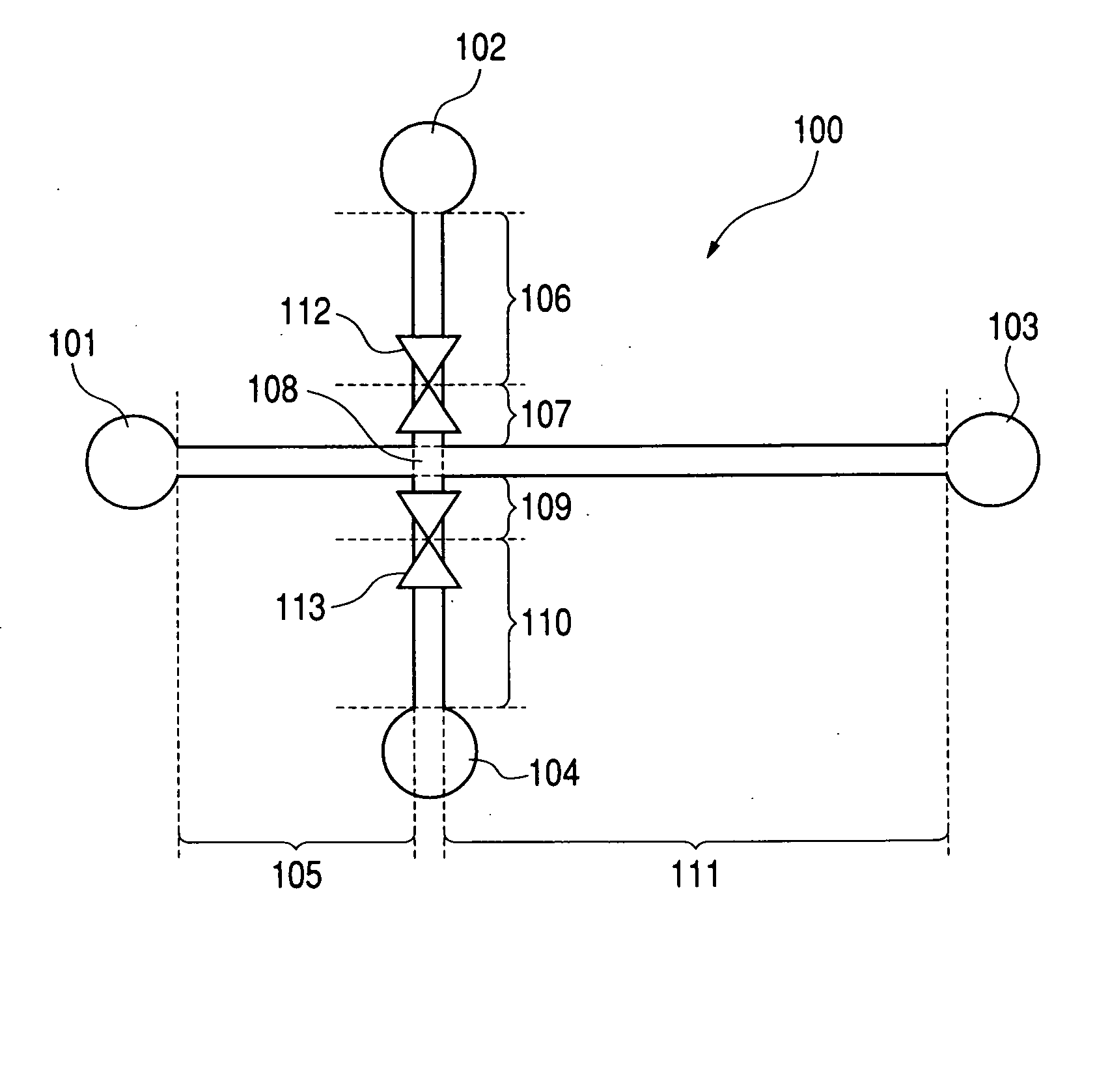Liquid delivery device
a liquid delivery and liquid technology, applied in the field of liquid delivery devices, can solve the problems of inability to use the above process, inability to retain the original composition of the sample during the delivery, and inability to achieve electrophoretic separation, so as to improve the reliability of analysis, reduce the dead volume, and reduce the delivery time
- Summary
- Abstract
- Description
- Claims
- Application Information
AI Technical Summary
Benefits of technology
Problems solved by technology
Method used
Image
Examples
example 1
[0117] In this Example, a liquid delivery device is practically produced which has valves controlled by pressure change of the fluid.
[0118]FIGS. 5A, 5B, and 5C show a specific example of production of the fluid delivery device shown in FIGS. 1A, 1B, and 1C. The fluid delivery device is constituted of substrates 500, 501, 502, 503, and 504 as shown in FIG. 5B. FIG. 5A is a plan view of substrate 500 in which channels shown in FIGS. 1A to 1C are formed. FIG. 5B is a sectional view taken along line 5B-5B in FIG. 5A. FIG. 5C is a plan view taken along line 5C-5C in FIG. 5A.
[0119]FIG. 5B shows specifically the route of fluid flow from flow channel 109 through the valve and flow channel 110 to reservoir 104. The fluid having passed through flow channel 109 in substrate 500 is injected via through-hole 505 in substrate 504 into large channel region 304 in substrate 503. Flat plate 301 provided in substrate 503 is displaced depending on the fluid pressure and the spring constant of spring...
example 2
[0132] With the device prepared above as shown in FIGS. 5A, 5B, and 5C, a unit for separation and analysis is constructed for analysis of a mixture solution containing benzoic acid, salicylic acid, and phenol by HPLC (high performance liquid chromatography). FIGS. 7A and 7B illustrate the unit schematically.
[0133] Unit 700 is constructed on a substrate, having first channel 710, second channel 703-704, third channel 711, fourth channel 706-707, injecting intersection 705, valve 708 in channel 703-704, and valve 709 in channel 706-707. Reservoir 701 is connected to the end of flow channel 703 at the side opposite to valve 708, and reservoir 702 is connected to the end of flow channel 707 at the side opposite to valve 709. Flow channel 710 is connected to pump 712 and flow controller 713 at the outside of unit 700 at the channel end opposite to intersection 705 for injection. Flow channel 711 is connected to an outside analysis apparatus, HPLC column 714, at the channel end opposite ...
example 3
[0140] With the device for analysis of FIGS. 5A, 5B, and 5C, an HPLC apparatus is constructed for separation and analysis of five kinds of proteins in a solution including glutamate dehydrogenase, lactate dehydrogenase, enolase, adenylate kinase, and cytochrome c. FIGS. 7A and 7B show the device schematically.
[0141] Unit 700 is constructed on a substrate, having first channel 710, second channel 703-704, third channel 711, fourth channel 706-707, injecting intersection 705, valve 708 in channel 703-704, valve 709 in channel 706-707. Reservoir 701 is connected to the end of flow channel 703 at the side opposite to valve 708, and reservoir 702 is connected to the end of flow channel 707 at the side opposite to valve 709. Flow channel 710 is connected to pump 712 and flow controller 713 at the outside of unit 700 at the channel end opposite to intersection 705 for injection. Flow channel 711 is connected to an outside analysis apparatus, HPLC column 714, at the channel end opposite to...
PUM
| Property | Measurement | Unit |
|---|---|---|
| size | aaaaa | aaaaa |
| thickness | aaaaa | aaaaa |
| pressure | aaaaa | aaaaa |
Abstract
Description
Claims
Application Information
 Login to View More
Login to View More - R&D
- Intellectual Property
- Life Sciences
- Materials
- Tech Scout
- Unparalleled Data Quality
- Higher Quality Content
- 60% Fewer Hallucinations
Browse by: Latest US Patents, China's latest patents, Technical Efficacy Thesaurus, Application Domain, Technology Topic, Popular Technical Reports.
© 2025 PatSnap. All rights reserved.Legal|Privacy policy|Modern Slavery Act Transparency Statement|Sitemap|About US| Contact US: help@patsnap.com



